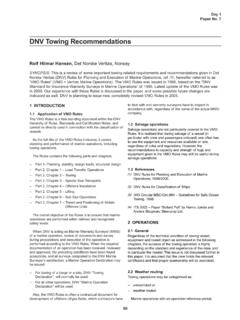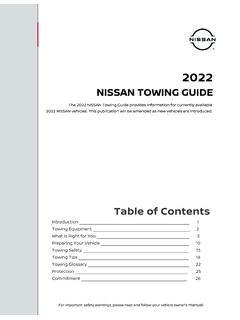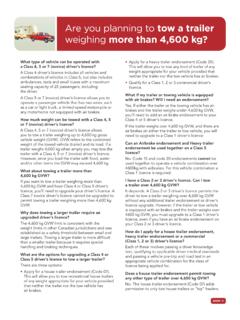Transcription of DNV Towing Recommendations - Tugmasters
1 Day 1. Paper No. 7. DNV Towing Recommendations Rolf Hilmar Hansen, Det Norske Veritas, Norway SYNOPSIS: This is a review of some important Towing related requirements and Recommendations given in Det Norske Veritas (DNV) Rules for Planning and Execution of Marine Operations, ref. /1/, hereafter referred to as VMO Rules (VMO = Veritas Marine Operations). The VMO Rules was issued in 1996, based on the DNV. Standard for Insurance Warranty Surveys in Marine Operations of 1985. Latest update of the VMO Rules was in 2000. Our experience with these Rules is discussed in the paper, and some possible future changes are indicated as well. DNV is planning to issue new, completely revised VMO Rules in 2005. 1 INTRODUCTION to deal with and warranty surveyors have to inspect in accordance with, regardless of the name of the actual MWS- Application of VMO Rules company. The VMO Rules is a free-standing document within the DNV. hierarchy of Rules, Standards and Certification Notes, and Salvage operations cannot be directly used in connection with the classification of Salvage operations are not particularly covered in the VMO.
2 Vessels. Rules. It is realised that during salvage of a vessel (in particular with crew and passengers onboard) one often has As the full title of the VMO Rules indicates, it covers to use the equipment and resources available on site, planning and performance of marine operations, including regardless of rules and regulations. However, the Towing operations. Recommendations to capacity and strength of tugs and equipment given in the VMO Rules may still be useful during The Rules contains the following parts and chapters: salvage operations. Part 1- Planning, stability, design loads, structural design. Part 2, Chapter 1 Load Transfer Operations References Part 2, Chapter 2 Towing /1/ DNV Rules for Planning and Execution of Marine Operations, 1996/2000. Part 2, Chapter 3 Special Sea Transports Part 2, Chapter 4 Offshore Installation /2/ DNV Rules for Classification of Ships. Part 2, Chapter 5 Lifting /3/ IMO Circular Guidelines for Safe Ocean Part 2, Chapter 6 Sub Sea Operations Towing , 1998.
3 Part 2, Chapter 7 Transit and Positioning of Mobile Offshore Units /4/ ITS 2002 Paper Bollard Pull by Hannu Jukola and Anders Skogman, Steerprop Ltd. The overall objective of the Rules is to ensure that marine operations are performed within defined and recognised safety levels. 2 OPERATIONS. When DNV is acting as Marine Warranty Surveyor (MWS) General of a marine operation, review of documents and survey Regardless of the technical condition of Towing vessel, during preparations and execution of the operation is equipment and towed object as addressed in the following performed according to the VMO Rules. When the required chapters, the success of the Towing operation is highly documentation of an operation has been received, reviewed depending on the standard and experience of the crew, and and approved, the prevailing conditions have been found in particular the master. This issue is not discussed further in acceptable, and all surveys completed to the DNV Marine this paper; it is assumed that the crew holds the relevant Surveyor's satisfaction, a Marine Operation Declaration may certificates and that proper seamanship will be exercised.
4 Be issued: For Towing of a barge or a ship, DNV Towing Weather routing Declaration , will normally be used. Towing operations may be categorised as;. For all other operations, DNV Marine Operation Declaration will be used. unrestricted or weather routed. Also, the VMO Rules is often a contractual document for development of offshore oil/gas fields, which contractors have Marine operations with an operation reference period, 69. exceeding 72 hours are normally defined as unrestricted procedures for departure and arrival as well as calls at operations. Environmental criteria for these operations shall intermediate ports. be based on extreme value statistics. However, the design criteria for determination of minimum Towing force for open The tow master (usually the tug master) shall familiarise sea Towing ( unrestricted Towing ) is fixed (see sect. ) himself with the Towing manual. and not based on actual statistics for the Towing route and season.
5 3 TUG. A Towing operation may be weather routed ( weather restricted) due to limitations on the towed object. Weather Type, size and classification of tug routed tows shall seek shelter if weather situations exceeding The Towing vessel can be a tug, an anchor handler, or a type the operation criteria are forecasted or experienced. Ports of that combines these functions with several others, and have refuge and/or area of shelter shall be defined in the Towing the Class Notation Tug . The main requirement is that the procedures. Entrance, geography and size of shelter shall be vessel must be equipped with a remote operated Towing considered. Weather routing criteria will normally be given as winch. The background for the Towing winch requirement is recommendation on the Towing certificate/declaration issued at all times to have the flexibility to adjust the length of the by the MWS. Towing line according to environmental conditions, water depth, other traffic, and width of the navigated area.
6 Regardless of category (unrestricted/weather routed) of Formally there is no minimum size/length of a tug, but the Towing operation, a tow out criteria of Beaufort Force 5 or vessels for open sea towage shall not have any service better for the coming 24 hours is normally applicable. The restrictions. Note that the VMO Rules penalise tugs of less intention with the tow out criteria is to allow time for than 45m length with respect to Towing efficiency, see familiarisation with the tow, and to ensure adequate distance below. to shore in case of adverse weather conditions. DNV is considering redundancy requirements on critical DNV experience: There have been weather routed Towing systems (propulsion, steering, winch, etc.) for tugs operations where the forecast for the route seems not performing Towing of high value objects in the next revision being conscientiously assessed onboard the tug, and bad of the VMO Rules. weather encountered resulting in towline breakage and/or damage to the towed object.
7 In principle, such action of the The tug must, of course, hold valid statutory certificates tug master (or lack of action!) may be classified as breach and trading permit and will be inspected by the MWS prior to of warranty and may render the insurance of the towed commencement of the Towing operation. Class is formally not object invalid. required; a certificate from the national maritime authority is also acceptable. Voyage reporting Tugs with a Towing hook only ( no Towing winch) are not Daily voyage reporting to owners of tug and towed object is accepted by DNV for ocean Towing , but may be permitted for normally required, and should at least contain position, sea Towing in harbours or Towing jobs of short duration/length in condition, speed, ETA and status of tug and towed object. sheltered waters. The reports should be copied to the MWS. DNV experience: There have been a few cases where tugs DNV experience: Even if voyage reporting is given as a have been turned down at the time of inspection by the recommendation on the DNV Towing Declaration, the DNV marine surveyor due to gross overdue validity of report is often not copied to DNV.
8 This is unfortunate in certificates or a general unsatisfactory condition of the tug case of incidents occurring during the tow, and may cause ( fuel oil spill/leaks in the engine room). embarrassment towards the insurance. Minimum bollard pull of tug Towing manual According to the VMO Rules Towing force for open sea A Towing manual shall be prepared and distributed to key Towing shall be sufficient to maintain zero speed under the personnel. following conditions: The manual shall normally contain information regarding; sustained wind velocity VW = 20 (m/s), head current velocity VC = 1 (m/s), and tow out criteria, significant wave height HS = 5 (m). criteria for seeking shelter, Towing route, Towing force for coastal Towing and Towing in narrow or ports/areas of shelter, shallow waters representing a danger for grounding, shall be estimated Towing time (ETD, ETA), sufficient to maintain a speed over ground, in safe direction, of minimum 2 knots under defined environmental design environmental limitations structural capacity of conditions.
9 Note that for an area with strong current this may object, seafastening, etc., lead to higher Towing force than required for ocean tow. Also, contingency actions, passage through narrows may require additional tug(s). description of the ballast condition, connected to the stern of the towed object. reporting routines for progress of the tow, ETA, status, etc., Required tug bollard pull (BP) shall be estimated based on calculated required Towing force and tug efficiency in waves. contact persons and telephone numbers, expected environmental conditions for the intended Towing DNV experience: The DNV BP criteria seems to be route for the relevant season, and 70. established and accepted by the industry, even though the the BP certificate is issued by the classification society of current criteria is m/s, compared with m/s given in the vessel, after a BP test. Several of the classification the IMO Guidelines ref. /3/. Usually the current resistance societies (including DNV) have procedure for such tests is the least part of the calculated total Towing resistance which is more or less in line with the bollard pull test (contributions from wind, waves and current).
10 Procedure given in Appendix A of the IMO Guidelines ref. /3/. The adequacy or precision of the various BP test Tug efficiency procedures may of course be discussed, see ITS 2002. Unless more accurate calculations or model tests of Towing paper from Steerprop Ltd., ref. /4/. The DNV BP test efficiency of the tug in waves are made, the continuous procedure is therein considered to be one of the better ones. static bollard pull stated in the bollard pull certificate shall be We do however agree with Steerprop Ltd. that a more multiplied with an efficiency factor: detailed commonly accepted test procedure would be advantageous for the Towing industry and their clients. TE = (1 L). where Note that according to the VMO Rules the bollard pull certificate (and the test!) shall not be older than 10 years. TE : tug efficiency factor Also, if the vessel has undergone significant structural or L : tug length factor, L = (1 L/45)2 machinery changes a new bollard pull test may be required L: tug length (m), not to be taken more than 45 m and could also be advantageous with respect to the BP.





